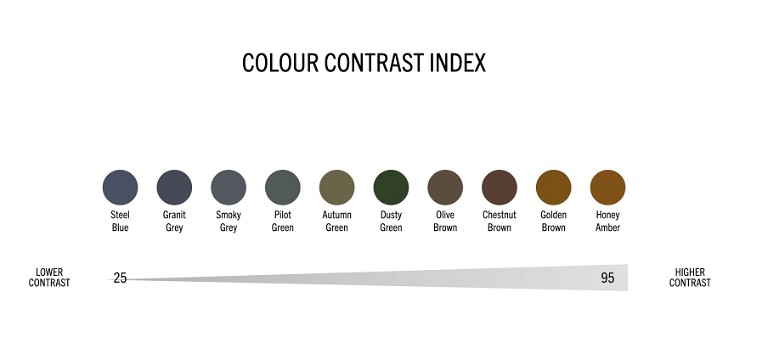mitechnology
Your Toolbox to Talk Tints
WRITER Nicola Peaper
Most of your patients probably don’t give much thought to lens tints. Yet different tints can make a significant difference to vision experience and even enhance performance.
Rather than simply asking your patient what colour they prefer, or if they want to match the tint that is already present in the frame, Nicola Peaper explains how you can take the opportunity to discuss different colours and their usage.
In Australia the most common tint colour, be it a simple plastic lens tint, polarising, or photochromic tint, is grey. While this may often give the best colour rendering – as it removes wavelengths across the visual light spectrum – it may not always be the most suitable for specific tasks and hobbies.
Scattered light increases glare and, due to its short wavelength, a large share of scattered light is in the blue part of the spectrum. As scattered light carries no useful visual information, it can be said that blue light reduces visual sharpness, affecting both contrast and depth of vision. To absorb blue light, a complementary colour is necessary. On a colour wheel, red, orange, and yellow are the colours that give the best results. However, while these colours will give the best levels of contrast, they are not aesthetically appealing and so brown and amber tints tend to be used for good contrast in a fashion frame.
COLOUR CONTRASTS
As it is often difficult to explain the difference between individual lens colours, and why one colour should be chosen over another, a colour contrast index (Figure 1) is useful. Created by Rodenstock, Lambda Technology can be used to give values to describe the level of contrast provided by the different lens colours. One of the aspects these are calculated on is the ratio between the amount of red light and the amount of blue light let through the lenses. This method is used, rather than percentages, to give an intuitive order to the colours. If purely percentages were used, the grey, green and brown lenses would be clustered together and the amber lens would be much further up the index. Using the index and tint samples, a discussion can be had to highlight two simple criteria for the spectacle wearer to consider when making their choice:

Figure 1.
1. What contrast level feels right?
2. What colour feel is right for me?
Colour feel is important as, while understanding levels of contrast, patients may still have a fixed view on what tint colour is ‘comfortable’ for them. Talking about the implications to vision of each colour allows the patient to at least make an informed choice.
If sunglasses are going to be worn during sports and hobbies, a more detailed conversation needs to take place. As mentioned earlier, red, orange, and yellow tints may not be aesthetically pleasing. But these tints may be far safer for certain sports, such as skiing or mountain biking where good contrast and depth perception are essential.
Rodenstock, within its Lambda Technology, has three contrast tints. These tints are in specific colours and transmissions, making them suitable for certain sports and weather conditions.
• Dynamic yellow (Figure 2a) has a yellow tint that will only block about 15% of light, but all of the light blocked will be blue wavelengths. Effectively, it brightens the surroundings making contours and details in the landscape more visible to the wearer. This tint is highly suitable for skiing or mountain biking in foggy or cloudy conditions.
• Dynamic orange has a 40% tint that is suitable for bright conditions, such as a reflective snow field, but with an overcast sky or little direct sunlight.
• Dynamic red (Figure 2b) increases contrast while significantly reducing glare as it is an 80% absorption tint. This is suitable for changing but mostly sunny conditions.
“ Talking about the implications to vision of each colour allows the patient to at least make an informed choice ”
ULTRAVIOLET LIGHT PROTECTION
No discussion of tinted spectacles with a patient is complete without considering ultraviolet (UV) light protection. In Australia, this means protection against light of wavelengths less than 400nm. All sunglasses should supply protection against both transmitted light and light reflected off the back surface of the lens. Transmission is taken care of by the lens material. All lens indexes over 1.5 automatically block UV light. Many manufacturers, including Rodenstock within its B.I.G. portfolio (Biometric Intelligent Glasses) now have UV400 1.5 index materials which, when tinted, will give protection against UV transmitted light. It is vital that the practitioner checks that this is the case with their lens supplier as it is the material, not the tint, that supplies the protection. If a basic 1.5 index material is used, it will only block UV to 350nm and requires an extra treatment during the tinting process to give full protection.
Back surface reflection of UV can be provided by an antireflection coating that has an extra layer in the stack aimed at UV wavelengths.
Often antireflection coatings are not considered with sunglasses as they push up the price of what may be a second pair and, if applied to the front surface, will reduce the efficacy of the tint. However, if we consider the fact that the pupil dilates behind a tinted lens, making the eye more susceptible to reflected light, a back surface antireflection coating will improve both the safety of the eye from UV and visual comfort.
POLARISING AND PHOTOCHROMICS
The colour contrast index can also be used as a discussion point for polarising filters, which generally have colours of grey, green, or brown.
Finally, the index can be used to discuss photochromic materials. Within its new Colormatic 3 portfolio, Rodenstock has four colours for everyday use: smoky grey, chestnut brown, pilot green, and steel blue, as well as four colours for photochromic sunglass tints.
The Colormatic 3 colours for everyday use will all give some level of contrast enhancement as, even when unactivated, they block blue wavelengths of 400 to 455nm by 32 to 35%, depending on the colour. These lenses are not available with a blue light antireflection coating as this would remove too much blue light for everyday use, especially for night driving.

Figure 2a.
It does mean that the Colormatic 3 tints are highly suitable for screen use and video conferencing, as they give a level of blue light protection without a disturbing reflection from a blue light multicoat.
The Colormatic 3 sunglass tints start with a minimum absorption of 45% and go to a maximum tint of 90%. The three fashion colours (smoky grey, chestnut brown, and fashion green) are added to with a contrast orange tint which starts at 40% orange and changes to a 90% absorption amber-brown colour. This is ideal for outdoor sports, such as golf, that may start at dawn and continue into a bright sunny day, giving a similar level of contrast as the dynamic orange and dynamic red solid tints.
HAVE THE DISCUSSION
With the introduction of a colour contrast index and contrast tints available in both solid tints and photochromic tints, Rodenstock has created a clear way to explain and highlight the benefits of various tint solutions.
Nicola Peaper BSc (Hons) Ophthalmic Optics, Cert 4 TAE, practised optometry in private and corporate practices in the United Kingdom for 20 years before moving to Australia in 2005. Since then, she has worked in fitting laboratories advising on procedures and quality. In roles as state and national training manager, she has gained extensive experience in presenting the technology behind, and the prescribing and fitting of, ophthalmic lenses. Ms Peaper is currently the National Professional Services Manager for Rodenstock.

Figure 2b.